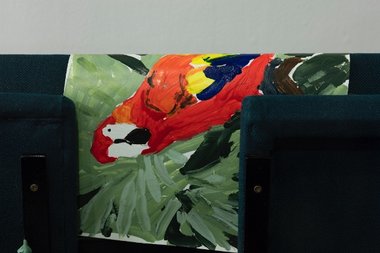John Hurrell – 24 February, 2016
Considering this show seems to be about absorbing knowledge via the teacher's methods of controlling guidance, there is more individuality within the performance residue than you might anticipate. And because individuality is valued overall in the art system, the interest in Hand Over Hand in a university context seems somewhat conflicted, perhaps motivated by sarcasm. Especially when, at the bottom of the exhibition's handout, the Rancière book is referred to in a quote as ‘a manual of autistic practice'.
An exhibition which investigates the process of teaching called Hand Over Hand (HOH), the triumph of the old master is a performance where ‘teacher’ and ‘student’ alternate in roles exploring manual dexterity in painting. This they do by copying photographs of parrots (aptly ironic subject passingly referred to by Jacques Rancière) using coloured inks, brushes and glossy paper. The laying over of hands (teacher over pupil, and then role swapping) - as a pedagogical technique - is part of this.
With Window being in the university library foyer, and a title taken from Rancière’s The ignorant schoolmaster, the event appears to question the authority and power relations of the university throughout the teaching process. It examines the social relations and the subjugating processes involved, and might even allude to the educational theories (involving researched role models) of secondary school art curriculum organisers like Ted Bracey or Peter Smith in the seventies and eighties.
So beyond seeing or participating in the performative aspects of the work (the show has a ‘closing’ this evening), the display in the Window frontage presents about forty images in coloured ink haphazardly pinned on the back wall, with some overlapping. The pairs have been split up.
Two painted pages are at the front on the glass: one on top of the clear surface, the other behind. One is placed on the row of flip-seat chairs on the floor, two other sheets are on the floor, and another is jammed up against the wall. Most of the rendered parrots are aligned from top left to bottom right, but about fifteen are the mirrored reverse.
These paintings are surprisingly varied, even though most have hot colourful plumage (primary and secondary colours) and subdued foliage in the background (tertiaries). A few are fragmented, or don’t use all of the paper, or emphasize the rhythm of horizontal brushmarks at the expense of expressive description.
Considering this show seems to be about absorbing knowledge via the teacher’s methods of controlling guidance, there is more individuality within the displayed performance residue than you might anticipate. And because individuality is valued overall in the art system, the interest in Hand Over Hand in a university context seems somewhat conflicted, perhaps motivated by sarcasm. Especially when, at the bottom of the exhibition’s handout, the Rancière book is referred to in a quote as ‘a manual of autistic practice’.
Outside of the amusing ‘artistic’ pun, when I think of autism I think of obsessive repetition: hyper children constantly flicking the edges of pages of a thick phone directory, or endlessly waving their hands back and forth under a running tap. A fascination with rhythm and sensation.
Rancière is especially interested in the teaching methods of the teacher, Joseph Jacotot (1770 -1840)) that encouraged an apparently inexplicable osmosis achieved through ‘parrotting’ surface qualities, whereas an educator like Ted Bracey for example, was fascinated by Gilbert Ryle‘s attack on the distinction between ‘knowing how’ and ‘knowing that’, believing that theory and practice cannot be separated. I’m guessing that somehow the two areas of research (Rancière’s and Ryle’s) are vaguely related.
Rancière’s enthusiasm for Jacotot is based on the latter’s view of equality between pupil and teacher with no hierarchy, and faith in the pupil’s innate intelligence where they don’t have to be instructed, but can figure things out for themselves independently, if so inclined.
the triumph of the old master fascinates because it looks at this free will, and the subtle resisting tension between upper hand and lower. It is not about confining control but freedom of thought and body; the nurturing of confidence without being dominated by incessant (and smothering) explanation.
John Hurrell

 Advertising in this column
Advertising in this column Two Rooms presents a program of residencies and projects
Two Rooms presents a program of residencies and projects



This Discussion has 0 comments.
Comment
Participate
Register to Participate.
Sign in
Sign in to an existing account.